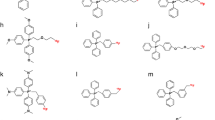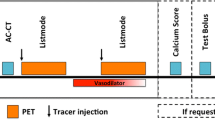Abstract
Myocardial perfusion imaging is a widely used approach to noninvasively identify myocardial ischemia and guide therapies. It is typically performed using single photon emission computed tomography. The competing technology positron emission tomography (PET) offers higher diagnostic accuracies but suffers from logistical limitations due to the use of short-lived radioisotopes. New 18F-labeled perfusion markers were introduced in the past years and offer simplified supply approaches, as known from oncologic PET imaging. This review summarizes the available literature especially from preclinical studies, but also very recent findings from early clinical trials. We discuss the consequences of long-lived radioisotopes in myocardial PET and the potential role of absolute blood flow quantification to establish efficient clinical protocols.


Similar content being viewed by others
References
Papers of particular interest, published recently, have been highlighted as: • Of importance
Klocke FJ, Baird MG, Lorell BH, Bateman TM, Messer JV, Berman DS, O’Gara PT, Carabello BA, Russell RO, Jr., Cerqueira MD, St John Sutton MG, DeMaria AN, Udelson JE, Kennedy JW, Verani MS, Williams KA, Antman EM, Smith SC, Jr., Alpert JS, Gregoratos G, Anderson JL, Hiratzka LF, Faxon DP, Hunt SA, Fuster V, Jacobs AK, Gibbons RJ, Russell RO: ACC/AHA/ASNC guidelines for the clinical use of cardiac radionuclide imaging—executive summary: A report of the American college of Cardiology/American Heart Association task force on practice guidelines (ACC/AHA/ASNC committee to revise the 1995 guidelines for the clinical use of cardiac radionuclide imaging). J Am Coll Cardiol 2003;42:1318–1333.
Salerno M, Beller GA: Noninvasive assessment of myocardial perfusion. Circ Cardio-vasc Imaging 2009;2:412–424.
Hachamovitch R, Berman DS: The use of nuclear cardiology in clinical decision mak-ing. Semin Nucl Med 2005;35:62–72.
Hachamovitch R, Berman DS, Kiat H, Cohen I, Friedman JD, Shaw LJ: Value of stress myocardial perfusion single photon emission computed tomography in patients with normal resting electrocardiograms: An evaluation of incremental prognostic value and cost-effectiveness. Circulation 2002;105:823–829.
Schwaiger M, Ziegler SI, Nekolla SG: PET/CT challenge for the non-invasive diagnosis of coronary artery disease. Eur J Radiol 2010;73:494–503.
Bergmann SR, Fox KA, Rand AL, McElvany KD, Welch MJ, Markham J, Sobel BE: Quantification of regional myocardial blood flow in vivo with h215o. Circulation 1984;70:724–733.
Hutchins GD, Schwaiger M, Rosenspire KC, Krivokapich J, Schelbert H, Kuhl DE: Noninvasive quantification of regional blood flow in the human heart using n-13 ammonia and dynamic positron emission tomographic imaging. J Am Coll Cardiol 1990;15:1032–1042.
vom Dahl J, Muzik O, Wolfe ER, Jr., Allman C, Hutchins G, Schwaiger M: Myocar-dial rubidium-82 tissue kinetics assessed by dynamic positron emission tomography as a marker of myocardial cell membrane integrity and viability. Circulation 1996;93:238–245.
Lautamaki R, George RT, Kitagawa K, Higuchi T, Merrill J, Voicu C, DiPaula A, Ne-kolla SG, Lima JA, Lardo AC, Bengel FM: Rubidium-82 pet-ct for quantitative assessment of myocardial blood flow: Validation in a canine model of coronary artery stenosis. Eur J Nucl Med Mol Imaging 2009;36:576–586.
Marshall RC, Powers-Risius P, Reutter BW, O’Neil JP, La Belle M, Huesman RH, VanBrocklin HF: Kinetic analysis of 18f-fluorodihydrorotenone as a deposited myocardial flow tracer: Comparison to 201tl. J Nucl Med 2004;45:1950–1959.
Madar I, Ravert HT, Du Y, Hilton J, Volokh L, Dannals RF, Frost JJ, Hare JM: Char-acterization of uptake of the new pet imaging compound 18f-fluorobenzyl triphenyl phospho-nium in dog myocardium. J Nucl Med 2006;47:1359–1366.
Yalamanchili P, Wexler E, Hayes M, Yu M, Bozek J, Kagan M, Radeke HS, Azure M, Purohit A, Casebier DS, Robinson SP: Mechanism of uptake and retention of f-18 bms-747158-02 in cardiomyocytes: A novel pet myocardial imaging agent. J Nucl Cardiol 2007;14:782–788.
Yu M, Guaraldi MT, Mistry M, Kagan M, McDonald JL, Drew K, Radeke H, Azure M, Purohit A, Casebier DS, Robinson SP: Bms-747158-02: A novel pet myocardial perfusion imaging agent. J Nucl Cardiol 2007;14:789–798.
Schuler F, Casida JE: The insecticide target in the psst subunit of complex i. Pest Manag Sci 2001;57:932–940.
Huisman MC, Higuchi T, Reder S, Nekolla SG, Poethko T, Wester HJ, Ziegler SI, Casebier DS, Robinson SP, Schwaiger M: Initial characterization of an 18f-labeled myocardial perfusion tracer. J Nucl Med 2008;49:630–636.
Madar I, Ravert H, Dipaula A, Du Y, Dannals RF, Becker L: Assessment of severity of coronary artery stenosis in a canine model using the pet agent 18f-fluorobenzyl triphenyl phosphonium: Comparison with 99mtc-tetrofosmin. J Nucl Med 2007;48:1021–1030.
Higuchi T, Nekolla SG, Huisman MM, Reder S, Poethko T, Yu M, Wester HJ, Case-bier DS, Robinson SP, Botnar RM, Schwaiger M: A new 18f-labeled myocardial pet tracer: Myocardial uptake after permanent and transient coronary occlusion in rats. J Nucl Med 2008;49:1715–1722.
Sherif HM, Saraste A, Weidl E, Weber AW, Higuchi T, Reder S, Poethko T, Henrik-sen G, Casebier D, Robinson S, Wester HJ, Nekolla SG, Schwaiger M: Evaluation of a novel (18)f-labeled positron-emission tomography perfusion tracer for the assessment of myocardial infarct size in rats. Circ Cardiovasc Imaging 2009;2:77–84.
• Nekolla SG, Reder S, Saraste A, Higuchi T, Dzewas G, Preissel A, Huisman M, Po-ethko T, Schuster T, Yu M, Robinson S, Casebier D, Henke J, Wester HJ, Schwaiger M: Evaluation of the novel myocardial perfusion positron-emission tomography tracer 18f-bms-747158-02: Comparison to 13n-ammonia and validation with microspheres in a pig model. Circulation 2009;119:2333–2342. This article reports on the first use of a new fluorinated flow tracer in a large animal model in a clinical PET system. It showed superior imaging properties of this tracer compared with 13 N ammonia and demonstrated its potential for absolute blood flow quantification.
Yu M, Bozek J, Guaraldi M, Kagan M, Azure M, Robinson SP: Cardiac imaging and safety evaluation of bms747158, a novel pet myocardial perfusion imaging agent, in chronic myocardial compromised rabbits. J Nucl Cardiol 2010;17:631–636.
Sherif H, Nekolla S, Saraste A, Reder S, Yu M, Robinson S, Schwaiger M: Simplified quantification of myocardial blood flow with 18f bms-747158-02: Comparison to kinetic modeling and microspheres in a pig model. J NUCL Med MEETING ABSTRACTS 2010:263.
Lazewatsky J, Azure M, Guaraldi M, Kagan M, MacDonald J, Yu M, Robinson SP: Dosimetry of bms747158, a novel 18f labeled tracer for myocardial perfusion imaging, in nonhuman primates at rest. J Nucl Med 2008;49:15P.
Maddahi J SC, Czernin J, Huang H, Schelbert H, Wijatyk A, Hibberd M, Lazewatsky J, Sparks R Phelps M: First human study of bms747158, a novel f-18 labeled tracer for myo-cardial perfusion imaging. J Nucl Med 2008;49:70P.
Tamarappoo B, Nakazato R, Shmilovich H, Hayes S, Thomson L, Friedman J, Ger-mano G, Slomka P, Ehlgen A, Berman D: Comparison of myocardial stress perfusion defect assessment using 99mtc sestamibi SPECT vs bms747158 pet. Journal of Nuclear Medicine 2010;51 (Supplement 2):153.
Maddahi J, Czernin J, Ehlgen A, Lazewatsky J, Zhu Q, Phelps M: Comparison of f-18 labeled bms747158 pet and tc-99m labeled SPECT myocardial perfusion imaging for detection and evaluation of coronary artery disease. J Am Coll Cardiol 2010;55:A65.E616.
Lazewatsky J, Maddahi J, Berman D, Bhat1 G, Sinhg S, Devine M, Case J, Ehlgen A: Development of a method for the determination of dose ratio and minimum inter-injection interval for a one-day rest-stress protocol with bms747158 pet myocardial perfusion agent. J Nucl Med 2010;51 (Supplement 2):600.
Parkash R, deKemp RA, Ruddy TD, Kitsikis A, Hart R, Beauchesne L, Williams K, Davies RA, Labinaz M, Beanlands RS: Potential utility of rubidium 82 pet quantification in patients with 3-vessel coronary artery disease. J Nucl Cardiol 2004;11:440–449.
Yoshinaga K, Katoh C, Noriyasu K, Iwado Y, Furuyama H, Ito Y, Kuge Y, Kohya T, Kitabatake A, Tamaki N: Reduction of coronary flow reserve in areas with and without ischemia on stress perfusion imaging in patients with coronary artery disease: A study using oxygen 15-labeled water pet. J Nucl Cardiol 2003;10:275–283.
Knuuti J, Kajander S, Maki M, Ukkonen H: Quantification of myocardial blood flow will reform the detection of cad. J Nucl Cardiol 2009;16:497–506.
Schindler TH, Schelbert HR, Quercioli A, Dilsizian V: Cardiac pet imaging for the detection and monitoring of coronary artery disease and microvascular health. JACC Cardio-vasc Imaging;3:623-640.
• Hajjiri MM, Leavitt MB, Zheng H, Spooner AE, Fischman AJ, Gewirtz H: Compari-son of positron emission tomography measurement of adenosine-stimulated absolute myocardial blood flow versus relative myocardial tracer content for physiological assessment of coronary artery stenosis severity and location. JACC Cardiovasc Imaging 2009;2:751–758. This study reports on the feasibility of stress-only imaging with absolute blood flow quantification. Due to the relatively long half-life of fluor-labeled PET perfusion markers, such an examination strategy can be a viable approach for time and cost-efficient clinical protocols.
Disclosure
No potential conflicts of interest relevant to this article were reported.
Author information
Authors and Affiliations
Corresponding author
Rights and permissions
About this article
Cite this article
Nekolla, S.G., Saraste, A. Novel F-18–Labeled PET Myocardial Perfusion Tracers: Bench to Bedside. Curr Cardiol Rep 13, 145–150 (2011). https://doi.org/10.1007/s11886-010-0159-9
Published:
Issue Date:
DOI: https://doi.org/10.1007/s11886-010-0159-9




